英语并列句解析及例句
中考英语语法复习:并列句用法及例题解析

中考英语语法复习:并列句一、并列句的构成:并列句是由并列连词and,but,or,for,so等把两个或两个以上互不依从,但意思紧密联系的简单句连在一起而构成的句子。
其结构为:简单句+并列连词+简单句。
二、并列句的分类:1. 表示同等关系的并列句这类并列句常用并列连词and连接前后简单句,and常译为“和”、“并且”,也可不译出来。
例如:He likes playing football and he plays well.他喜欢踢足球,并且踢得很好。
Last year l met Kate and we became friends.去年我和凯特相遇,我们成了朋友。
2. 表示转折关系的并列句这类并列句常用并列连词but(但是),yet(可是),while(而,另一方面),however(可是)等连接前后简单句,but常译为“但是”,“可是”,切不可与从属连词though或although一起使用。
例如:It has no mouth, but it can talk. 它没有嘴巴,但是它会说话。
School is over, yet all the teachers are still working.学校放学了,可是老师们仍然在工作。
He wants to be a writer, while I want to be a scientist. 他想当作家,而我则想当科学家。
It's raining hard, however, we must go out. 雨下得很大,然而我们必须出去。
3. 表示选择关系的并列句这类并列句常用并列连词or(或者,否则)等连接前后简单句。
or有两重含义:(1)译为“或者”,表示选择。
例如:Now you can have a rest or you can go to the cinema.现在你可以休息,或者去看电影。
(2)译为“否则”、“要不然”,表示条件。
英语并列句解析及例句
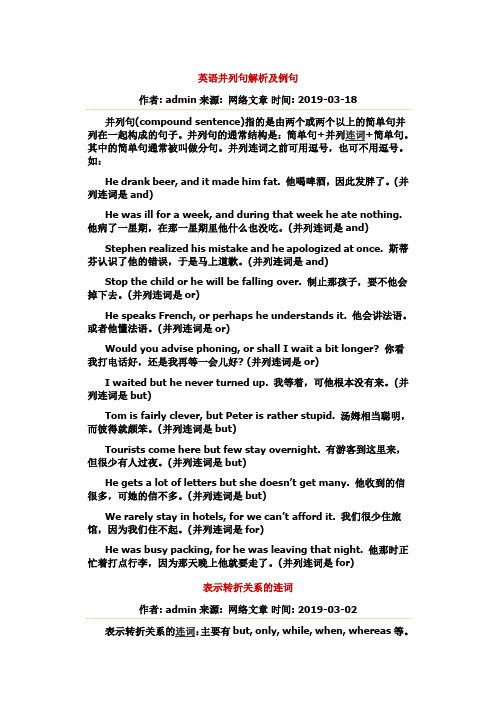
英语并列句解析及例句并列句(compound sentence)指的是由两个或两个以上的简单句并列在一起构成的句子。
并列句的通常结构是:简单句+并列连词+简单句。
其中的简单句通常被叫做分句。
并列连词之前可用逗号,也可不用逗号。
如:He drank beer, and it made him fat. 他喝啤酒,因此发胖了。
(并列连词是and)He was ill for a week, and during that week he ate nothing. 他病了一星期,在那一星期里他什么也没吃。
(并列连词是and) Stephen realized his mistake and he apologized at once. 斯蒂芬认识了他的错误,于是马上道歉。
(并列连词是and)Stop the child or he will be falling over. 制止那孩子,要不他会掉下去。
(并列连词是or)He speaks French, or perhaps he understands it. 他会讲法语。
或者他懂法语。
(并列连词是or)Would you advise phoning, or shall I wait a bit longer? 你看我打电话好,还是我再等一会儿好? (并列连词是or)I waited but he never turned up. 我等着,可他根本没有来。
(并列连词是but)Tom is fairly clever, but Peter is rather stupid. 汤姆相当聪明,而彼得就颇笨。
(并列连词是but)Tourists come here but few stay overnight. 有游客到这里来,但很少有人过夜。
(并列连词是but)He gets a lot of letters but she doesn’t get many. 他收到的信很多,可她的信不多。
英语中并列句的四种类型

英语中并列句的四种类型Document serial number【LGGKGB-LGG98YT-LGGT8CB-LGUT-英语中并列句的四种类型一、联合关系常用的连词有 and( 同,和 ), when(=and just at this time 就在这时,然后 ), not only…but (also)…( 不仅……而且…… ), neither…nor… (既不……也不……)等。
如:He helps me and I help him. 他帮我,我帮他。
He not only gave us a lot of advice, but also helped us to study English. 他不仅给我们出很多建议并且还帮助我学英语。
I was just leaving when the telephone rang. 我正要离开,电话铃响了。
注: when 作这种用法时,主要用于was/were doing sth. when sth./sb. did;was/were about to do sth. when sth./sb. did;was/were on the point of doing sth. when sth./sb. did等句型中,表示“当某人或某物正在或正要做某事,就在这时突然又发生了另一事”。
二、选择关系常用的连词有 or( 或者,否则 ), otherwise( 否则 ), or else( 否则 ), either...or( 不是……就是 ) 。
如:Hurry up, or (else) you’ll be la te. 快点,否则就会迟到了。
Will he still be there or will he have gone away? 你那时还在那里还是可能已经走了?You must go early, otherwise you will miss the bus. 你好得早点走,否则就赶不上公共汽车了。
英语中并列句的四种类型
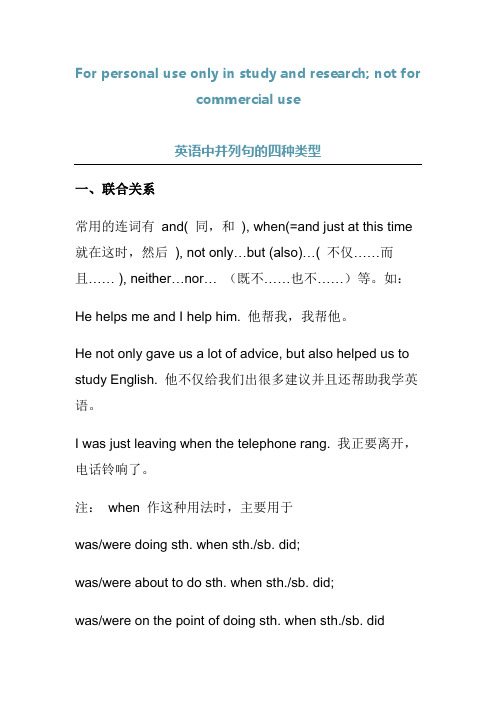
For personal use only in study and research; not forcommercial use英语中并列句的四种类型一、联合关系常用的连词有and( 同,和), when(=and just at this time 就在这时,然后), not only…but (also)…( 不仅……而且…… ), neither…nor… (既不……也不……)等。
如:He helps me and I help him. 他帮我,我帮他。
He not only gave us a lot of advice, but also helped us to study English. 他不仅给我们出很多建议并且还帮助我学英语。
I was just leaving when the telephone rang. 我正要离开,电话铃响了。
注:when 作这种用法时,主要用于was/were doing sth. when sth./sb. did;was/were about to do sth. when sth./sb. did;was/were on the point of doing sth. when sth./sb. did等句型中,表示“当某人或某物正在或正要做某事,就在这时突然又发生了另一事”。
二、选择关系常用的连词有or( 或者,否则), otherwise( 否则), or else( 否则), either...or( 不是……就是) 。
如:Hurry up, or (else) you’ll be late. 快点,否则就会迟到了。
Will he still be there or will he have gone away? 你那时还在那里还是可能已经走了?You must go early, otherwise you will miss the bus. 你好得早点走,否则就赶不上公共汽车了。
英语并列句解析

类
黾学
并 列 句 是 由ad,b t I o 等 并 列 连 词 把 两 个 或 两 个 以 上 n u ,0" r ,f
意 义 有 关 的 简单 句连 在 一 起 而构 成 的 句子 。其 结 构 为 : 简单 句 + 并 列连 词 +简 单 句 。并 列 句是 初 中 英语 语 法 的 重 点和 难 点 , 是 中考 也 的常考知识点之一 。
你 必 须 说 真话 , 则 你 将会 受 到 惩 罚 。 否
Eih r o c n o t y o re , r o c n s s me n es t t e y u a d i b y u s f o y u a a k o o e le o
d t 你 或 者 自己做 , 者 让 别 人 去 做 。 oi . 或 ☆ 特 别提 醒 : 祈 使 句 + r n + “ o/ d 简单 句 ” 也是 一 个 固定 句 型 , a 此
我想 和你 一 块 儿 去 , 可是 我 忙 不 过 来 。
☆特别提醒 : og ,tog( t uhahuh_ 、 ) h l  ̄然 尽管 不能与bt u( ) 。如 : 但是 连用
虽 然 他很 累 , 是 他 没有 停 止 工作 。 但
误 : l og ei vr i d b th o s ts p w rig At u h h s ey te , u ed en’ t okn . h r o
一
、
联 合 并 列Leabharlann 句 : n ( , 且 ) o ol… u l …( 但 …… ad 和 并 ,n t n b ta o 不 y s
而且 …… ) 。如 : 等
Jm ns e i h me r n e w n o b d i f ih d hs o wok a d h e tt e . i
并列句的结构及用法

并列句的结构及用法
并列句是由两个或多个相对独立的句子,并列连接词(如和、或、但、而、然后等)连接而成的句子。
它们在句意上是平行或并列的关系,一般用来表达两个或多个相对独立的主题或动作。
并列句的结构可以有以下几种形式:
1. 主语+ 动词+ 并列连词+ 主语+ 动词:他喜欢吃苹果,我喜欢吃橙子。
2. 主语+ 动词+ 并列连词+ 主语+ 动词+ 宾语:他买了一本书,我买了一本。
3. 主语+ 动词+ 并列连词+ 动词短语:我喜欢读书,也喜欢写作。
4. 主语+ 动词+ 宾语+ 并列连词+ 宾语:他学习数学,也学习英语。
并列句的用法主要有以下几种:
1. 表示并列关系:我喜欢打篮球,他喜欢踢足球。
2. 表示选择关系:你可以去参加聚会,或者去图书馆看书。
3. 表示对比关系:他很有才华,但缺乏实践经验。
4. 表示递进关系:她年龄小,却已经拥有了很多成就。
5. 表示因果关系:我感冒了,所以今天不去上课。
需要注意的是,并列句中的两个或多个句子要有相对独立的主题和谓语动词,句
子之间的关系要明确,并且在语法上要保持平行一致。
并列句(四种)
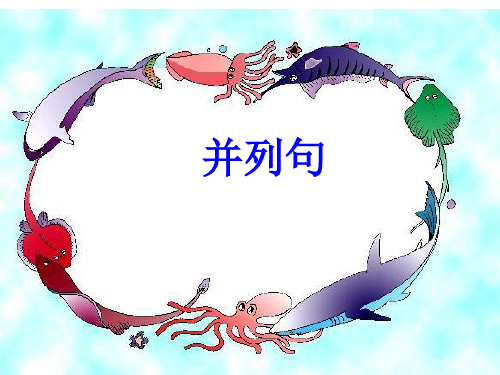
teacher never spoke English like that! The
porter and I looked at each other _a_n_d_smiled.
She’s good at English, but her Chinese isn’t good.
He worked hard, yet he failed.
Tom is tall while his brother is short.
I’d like to go with you, however my hands are full.
Jim finished his homework and he went to bed. 不但我到校早,而且我的老师也是如此。
Not only I come to school early, but also my teacher does.
2.转折并列句
并列连词:but(但是), however(然而), yet(但是), while(而,然而)等,表意思转折或对比 。
并列句
定义
并列句是由and, but, or, for等并列 连词把两个或两个以上意义有关的简 单句连在一起而构成的句子。其结构 为:简单句+并列连词+简单句。
1. 联合并列句
并列连词:and(和、并且), 其中and意为“和、又、 而”,表示动作先后等,not only...but also...(不 但……而且……)等。 吉姆写完作业,就上床睡觉了。
A. and B. though C. because D. or 4. I came to see her, ___A_____ she wasn’t at home.
英语并列句

并列句由并列连词连接、含有两个或更多主谓结构的句子叫并列句。
通常的并列连词,根据所连接的上下文的逻辑关系,可以分为以下几类:一、表示转折对比关系的并列连词1. but但是,可是,而,却连接两个简单句,有时句中某些词可以省略;连接两个并列成分,可以放在一个句子的句首,后面不接逗号。
例:I hope you don't mind me asking ,but where did you buy thoseshoes ?2. yet但是;尽管如此可连接两个句子,用逗号分开,也可在yet 前加and,还可以放在一个句子的句首。
例:The car is old,yet it is in good condition.3. while而,但是,可是,却while 作连词用时,可表示对比或转折关系。
例:I do every single bit of housework while my husband Bob just doesthe dishes now and then.(补充)however “但是,然而”,副词,常用逗号和句子分开,可位于句中,句尾,句首。
He said that it was so;he was mistaken,however.二、表示因果关系的并列连词1. for因为由并列连词for 引导的分句常置于句子后部,而且常用逗号与前面的分句隔开。
for 分句主要是对前一分句补充说明理由或推断原因。
for 分句不能用来回答why 问句。
It must have rained last night, for it is wet all over.2. so 因此可以连接两个句子,中间有时用逗号隔开;也可在so前加and ;还可以放在一个句子的句首。
例:The shop were closed so I didn’t get any milk. (注)a. 并列连词so不可与从属连词because 连用。
中考英语并列句知识点3篇
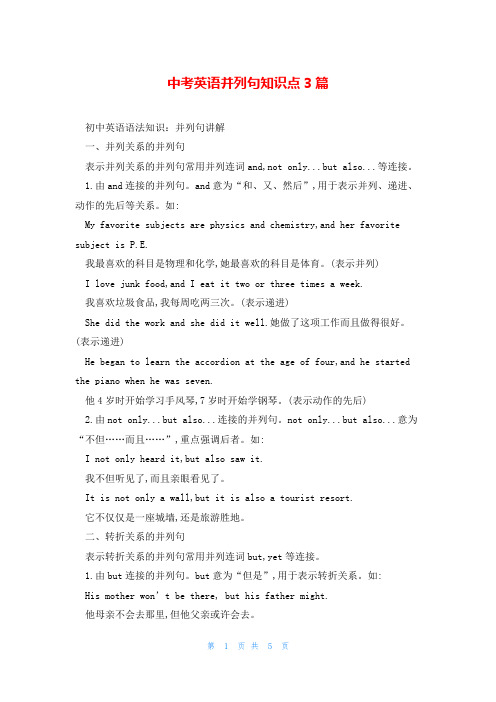
中考英语并列句知识点3篇初中英语语法知识:并列句讲解一、并列关系的并列句表示并列关系的并列句常用并列连词and,not only...but also...等连接。
1.由and连接的并列句。
and意为“和、又、然后”,用于表示并列、递进、动作的先后等关系。
如:My favorite subjects are physics and chemistry,and her favorite subject is P.E.我最喜欢的科目是物理和化学,她最喜欢的科目是体育。
(表示并列)I love junk food,and I eat it two or three times a week.我喜欢垃圾食品,我每周吃两三次。
(表示递进)She did the work and she did it well.她做了这项工作而且做得很好。
(表示递进)He began to learn the accordion at the age of four,and he started the piano when he was seven.他4岁时开始学习手风琴,7岁时开始学钢琴。
(表示动作的先后)2.由not only...but also...连接的并列句。
not only...but also...意为“不但……而且……”,重点强调后者。
如:I not only heard it,but also saw it.我不但听见了,而且亲眼看见了。
It is not only a wall,but it is also a tourist resort.它不仅仅是一座城墙,还是旅游胜地。
二、转折关系的并列句表示转折关系的并列句常用并列连词but,yet等连接。
1.由but连接的并列句。
but意为“但是”,用于表示转折关系。
如:His mother won’t be there, but his father might.他母亲不会去那里,但他父亲或许会去。
英语中并列句的定义

并列句(Compound Sentence)是由两个或更多独立子句(Independent Clauses)组成的句子结构。
每个独立子句都可以独立存在,并且它们之间通过逗号、分号、连词或冒号等连接。
并列句的目的是将多个相关的思想或事件并列在一起,以表达并列或相对的关系。
以下是一些例子来说明并列句的使用:1."I love to swim, and my sister enjoys playing tennis."(我喜欢游泳,而我姐姐喜欢打网球。
)这个句子由两个独立子句组成,通过连词"and" 连接。
每个子句都可以独立存在,并且表达了两个不同的兴趣爱好。
2."He finished his work, so he decided to go for a walk."(他完成了工作,所以决定去散步。
)这个句子由两个独立子句组成,通过逗号和连词"so" 连接。
第一个子句表达了完成工作的动作,而第二个子句表达了由此而来的决定。
3."She sings beautifully, dances gracefully, and acts brilliantly."(她唱歌美妙,舞蹈优雅,演技出色。
)这个句子由三个独立子句组成,通过逗号连接。
每个子句都描述了她在不同方面的优秀表现。
4."She studied hard for the exam; however, she didn't perform well."(她为考试努力学习,然而她表现不佳。
)这个句子由两个独立子句组成,通过分号和转折连词"however" 连接。
两个子句表达了对比关系,强调了学习努力和考试表现之间的差异。
并列句的使用能够丰富句子结构,使句子更加连贯,同时也可以展示不同的想法、行动或描述之间的关系。
英语中的并列句
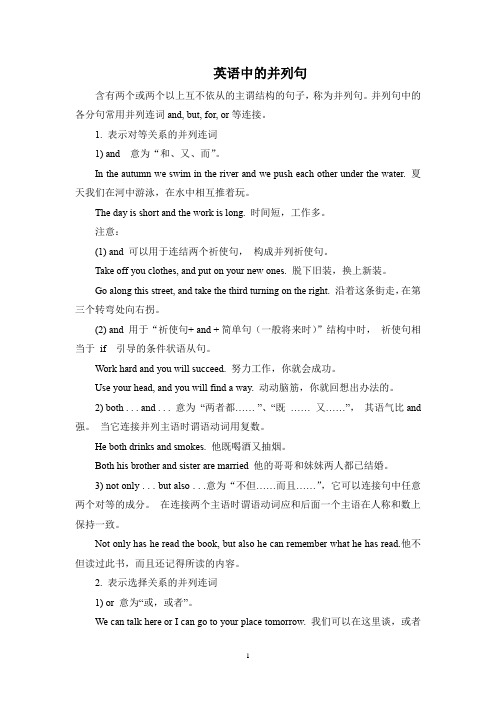
英语中的并列句含有两个或两个以上互不依从的主谓结构的句子,称为并列句。
并列句中的各分句常用并列连词and, but, for, or等连接。
1. 表示对等关系的并列连词1) and 意为“和、又、而”。
In the autumn we swim in the river and we push each other under the water. 夏天我们在河中游泳,在水中相互推着玩。
The day is short and the work is long. 时间短,工作多。
注意:(1) and 可以用于连结两个祈使句,构成并列祈使句。
Take off you clothes, and put on your new ones. 脱下旧装,换上新装。
Go along this street, and take the third turning on the right. 沿着这条街走,在第三个转弯处向右拐。
(2) and 用于“祈使句+ and +简单句(一般将来时)”结构中时,祈使句相当于if 引导的条件状语从句。
Work hard and you will succeed. 努力工作,你就会成功。
Use your head, and you will find a way. 动动脑筋,你就回想出办法的。
2) both . . . and . . . 意为“两者都…… ”、“既…… 又……”,其语气比and 强。
当它连接并列主语时谓语动词用复数。
He both drinks and smokes. 他既喝酒又抽烟。
Both his brother and sister are married 他的哥哥和妹妹两人都已结婚。
3) not only . . . but also . . .意为“不但……而且……”,它可以连接句中任意两个对等的成分。
在连接两个主语时谓语动词应和后面一个主语在人称和数上保持一致。
全角度剖析英语并列句的本质及用法

浅析并列句张贵元,甘肃漳县第一中学748300并列句是指两个或两个以上意义相关、层次相同、句法功能相同,并由并列连词或其他并列手段连接起来的主谓结构。
并列句的结构是:“简单句+并列连词+简单句”,去掉连词后都可以独立成句。
由此可以看出,并列句必须有两个或两个以上的主谓结构。
如果两个并列的主语,只有一个谓语动词;或者一个主语有两个或两个以上的谓语动词;或者两个并列的主语,两个并列的谓语,这样的句子仍然都是简单句。
试比较:1. Liming and Mary stood up and went out. 李明和玛丽站起来走了出去。
(简单句)2. She stood up and went out. 她站起来走了出去。
(简单句)3. Tom and his parents stood up and went out. 汤姆和他的父母亲站起来走了出去。
(简单句)4. Tom stood up and then he went out. 汤姆站起来,然后他走了出去。
(并列句)并列句是根据连接句子的词分类的。
这些词不仅简单地连接这些句子,更重要的是在被连接的句子之间建立某种关系。
因而并列句里两个句子的关系更为明确,而不像两个单独的句子关系松散,没有明确标明。
并列句可以分为联合关系(同等关系)、假设和条件关系、选择关系、转折关系、因果关系和对比关系等。
一、表示联合关系(同等关系)的并列句同等关系并列句分两种,一种是以and, not only …but also, neither … nor等为代表的表示语义引申或补充的并列连词连接起来的并列句。
另一种是以besides , moreover, furthermore, in addition, what’s more 等为代表的表示语义引申或递进关系的副词连接词连接起来的并列句。
这些同等关系的词连接的句子在语法地位上是平等一致的。
例句:After supper, Lifang came in and she looked worried.晚饭后李芳进来了,她看起来很着急。
英语四种并列句例句

英语四种并列句例句一、转折并列句主要由 but(但是), yet(可是), while(而,却)等连词连接。
如:I would have written before but I have been ill.我本该早写信的,但我生病了。
I have failed, yet I shall try again.我失败了,但我还要尝试。
You like tennis, while I’d rather read.你爱打网球,但我爱看书。
二、选择并列句主要由or(或者,还是,否则),either…or…(不是…就是…), neither…or…(既不…也不…),otherwise(要不然)等连词连接。
Be careful about what you say or you may regret it.当心你讲的话,否则你会后悔的。
Either say you’re sorry or else get out!你要么道歉,要么滚开!Neither does he smoke nor does he drink.他既不抽烟也不喝酒。
Seize the chance, otherwise you will regret it.要抓住机会,否则你会后悔的。
注:neither…nor…连接两个句子,注意用倒装语序。
三、联合并列句主要由and,not only…but also…(不但…而且…),when(=and just at this time 就在这时)等连词连接。
如:Give him an inch and he will take a mile.他会得寸进尺。
Not only did he speak more correctly, but he spoke more easily.不仅他讲得更正确,也讲得更不费劲了。
He was about to go to bed when the telephone rang.他正要上床睡觉,这时电话铃响了起来。
并列句的英语语法总结

并列句的英语语法总结并列句的英语语法总结并列句由并列连词连接、含有两个或更多主谓构造的句子叫并列句。
一、表示转折比照关系的并列连词1. but 但是,可是,而,却连接两个简单句,有时句中某些词可以省略;连接两个并列成分,可以放在一个句子的句首,后面不接逗号。
例:I hope you don't mind me asking, but where did you buy those shoes?2. yet 但是;尽管如此可连接两个句子,用逗号分开,也可在yet前加and,还可以放在一个句子的句首。
例:The car is old, yet it is in good condition. 这辆车旧了,但车况很好。
3. while 而,但是,可是,却while作连词用时,可表示比照或转折关系。
例:I do every single bit of housework while my husband Bob just does the dishes now and then.二、表示因果关系的并列连词1. for 因为由并列连词for引导的分句常置于句子后部,而且常用逗号与前面的分句隔开。
for分句主要是对前一分句补充说明理由或推断原因。
for分句不能用来答复why问句。
例:I did my best not to show pleasure, but what I was feeling was pure happiness, for my words had the power to make people laugh.2. so 因此可以连接两个句子,中间有时用逗号隔开;也可在so前加and;还可以放在一个句子的句首。
例:The shop doesn't open until 11 a.m., so it loses a lot of business.三、表示选择关系的'连词oror连接并列成分时,意为“或者,还是”;用于否认句中,意为“也不”,这时不宜用and;还有“否那么,要不然”之意,相当于otherwise。
英语-并列句剖析

❖ 你不仅风趣而且机智。 ❖ Not only are you funny,but also you are witty. ❖ 他正要上床睡觉,这时电话铃响了起来。
❖ He was about to go to bed when the telephone rang. ❖ 他没有去,他的兄弟也没有去。 ❖ He did not go,nor did his brother go. ❖ 吉姆踢足球,他的兄弟也踢足球。 ❖ Jim plays football and so does his brother. ❖ 一方面我得工作,另一方面我又有许多来访者。 ❖ On the one hand I have to work,on the other
there later. 12. 表示选择。
13. At last, we found ourselves in a pleasant
park with trees providing shade _a_n__d_sat
down to eat our picnic lunch. 13. 因sat 与found是并列谓语。
并列句
说明:由并列连词(如:and, so, but, or等)把 两个或两个以上的简单句连在一起而构成的 句子。
并列句=简单句+并列连词+简单句
例句:1. Give him an inch and he will take a mile. 2. Harry likes eggs, but he doesn’t like chicken.
❖ I have failed, yet I shall try again. ❖ 你爱打网球,但我爱看书。(while)
❖ You like tennis, while I’d rather read. ❖ 雨下得很大,我们却不得不出去。 (however) ❖ It is raining hard,however we have to go out. ❖ 他不是个吝啬鬼,相反,没有人比他更慷慨了。(on the
并列句的英语语法总结
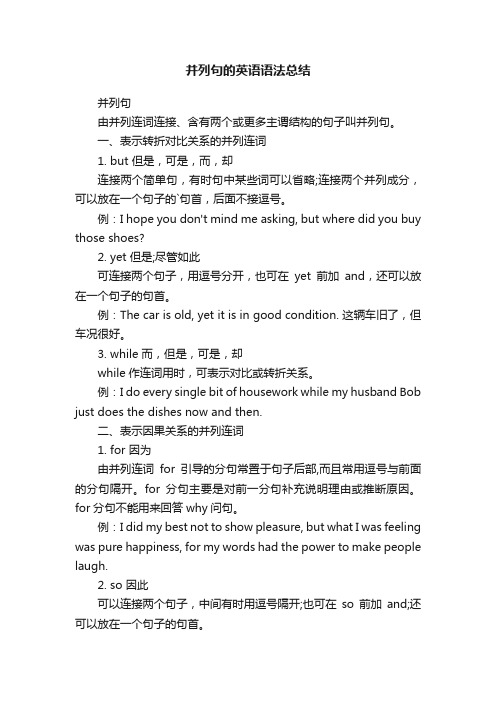
并列句的英语语法总结并列句由并列连词连接、含有两个或更多主谓结构的句子叫并列句。
一、表示转折对比关系的并列连词1. but 但是,可是,而,却连接两个简单句,有时句中某些词可以省略;连接两个并列成分,可以放在一个句子的`句首,后面不接逗号。
例:I hope you don't mind me asking, but where did you buy those shoes?2. yet 但是;尽管如此可连接两个句子,用逗号分开,也可在yet前加and,还可以放在一个句子的句首。
例:The car is old, yet it is in good condition. 这辆车旧了,但车况很好。
3. while 而,但是,可是,却while作连词用时,可表示对比或转折关系。
例:I do every single bit of housework while my husband Bob just does the dishes now and then.二、表示因果关系的并列连词1. for 因为由并列连词for引导的分句常置于句子后部,而且常用逗号与前面的分句隔开。
for分句主要是对前一分句补充说明理由或推断原因。
for分句不能用来回答why问句。
例:I did my best not to show pleasure, but what I was feeling was pure happiness, for my words had the power to make people laugh.2. so 因此可以连接两个句子,中间有时用逗号隔开;也可在so前加and;还可以放在一个句子的句首。
例:The shop doesn't open until 11 a.m., so it loses a lot of business.三、表示选择关系的连词oror连接并列成分时,意为“或者,还是”;用于否定句中,意为“也不”,这时不宜用and;还有“否则,要不然”之意,相当于otherwise。
- 1、下载文档前请自行甄别文档内容的完整性,平台不提供额外的编辑、内容补充、找答案等附加服务。
- 2、"仅部分预览"的文档,不可在线预览部分如存在完整性等问题,可反馈申请退款(可完整预览的文档不适用该条件!)。
- 3、如文档侵犯您的权益,请联系客服反馈,我们会尽快为您处理(人工客服工作时间:9:00-18:30)。
英语并列句解析及例句
并列句(compound sentence)指的是由两个或两个以上的简单句并
列在一起构成的句子。
并列句的通常结构是:简单句+并列连词+简单句。
其中的简单句通常被叫做分句。
并列连词之前可用逗号,也可不用逗号。
如:
He drank beer, and it made him fat. 他喝啤酒,因此发胖了。
(并列连词是and)
He was ill for a week, and during that week he ate nothing.
他病了一星期,在那一星期里他什么也没吃。
(并列连词是and)
Stephen realized his mistake and he apologized at once. 斯蒂芬认识了他的错误,于是马上道歉。
(并列连词是and)
Stop the child or he will be falling over. 制止那孩子,要不他会
掉下去。
(并列连词是or)
He speaks French, or perhaps he understands it. 他会讲法语。
或者他懂法语。
(并列连词是or)
Would you advise phoning, or shall I wait a bit longer? 你看我打电话好,还是我再等一会儿好? (并列连词是or)
I waited but he never turned up. 我等着,可他根本没有来。
(并列连词是but)
Tom is fairly clever, but Peter is rather stupid. 汤姆相当聪明,而彼得就颇笨。
(并列连词是but)
Tourists come here but few stay overnight. 有游客到这里来,
但很少有人过夜。
(并列连词是but)
他收到的信He gets a lot of letters but she doesn’t get many.
很多,可她的信不多。
(并列连词是but)
We rarely stay in hotels, for we can’t af
ford it. 我们很少住旅馆,因为我们住不起。
(并列连词是for)
He was busy packing, for he was leaving that night. 他那时正忙着打点行李,因为那天晚上他就要走了。
(并列连词是for)
表示转折关系的连词
作者: admin来源: 网络文章时间: 2019-03-02
表示转折关系的连词:主要有but, only, while, when, whereas等。
如A great deal has been accomplished, but more remains to
be done.
He is riding, while his father is walking in the dust.
Why did you borrow the book when you had one?
He is ill, whereas I am only a little tired.
only表示意义转折,只见于非正式文体。
如You may go, only come
back early.(only = but)
温馨提示:1 有些词或短语在句中也表示转折意义,如still, yet, however, all the same, after all等。
通常作连接性状语。
如The problem was a little hard, yet I was able to work it out
I explained twice, still he couldn't understand.
2 while在表示转折关系时,往往连接内容和结构对称的句子。
如I love strong tea while my father loves coffee.
的区别在于前者表示
3 both … and … not结构和neither … nor …
部分否定,而后者表示全部否定。
如Both you and I are not correct.
Neither you nor I am right.
表示选择关系的连词
作者: admin来源: 网络文章时间: 2019-03-02
表示选择关系的连词:主要有or, either … or, or else, whether … or, otherwise等。
如Which do you like better, tea or coffee?
Either you leave this hous e or I’ll call the police.
Do it at once, or else! = Do it at once, otherwise you will
suffer in some way.
Take a taxi, otherwise you won’t get there in time.
表示因果推理关系的连词:主要有so, for, then, therefore等。
表示因果推理关系的连词
作者: admin来源: 网络文章时间: 2019-02-22
表示因果推理关系的连词:主要有so, for, then, therefore等。
如The air here is polluted, so the crops are dying.
It must be late, for I have been here a long time.
温馨提示:for,because,as,since在用法和意义上的区别:
1 for引导的句子是并列分句,只能后置,并用逗号与前面的句子隔开。
主要用来表示推测性原因,或附带解释、说明前一分句的情况。
如The electric current must have been turned off, for the
light went out.
2 because用来引导表示直接原因的从句,语气很强,明确地说明因
果关系。
其引导的从句可置于句首、句末或句中。
如He is absent today because he is ill.
for引导分句表示因果关系时,它可以和because互换使用。
如上句也可以说成:He is asent today, for he is ill.
但表示推测性原因,就不能互换使用。
如He must be ill, for he is absent today.
3 since,as都是不讲自明的原因,是已知的原因,as的语气比since 要弱。
如Since (As) you don't feel well, you had better stay at
home.。
